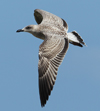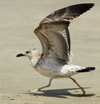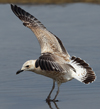 Larus armenicus
Larus armenicus
(last update:
| 1cy armenicus: August
This website deals with the Armenian Gull taxon armenicus, which is a common migrant and winter visitor to Israel from late July to late March (adults) and even April-May (non-adults). The Turkish breeding population has been quite stable over the last decades, and is about 2.400 pairs. It seems to have been constant at Tuz Golu during the past three decades, but apparently declining at Van Golu (due to predation at Ahtamar Island). Together with 11.000-13.000 pairs at two lakes in Armenia and 4.000-5.000 pairs at one lake in Iran, the world population may be around 20.000 breeding pairs. All large colonies are located on predator-free islands in large highland lakes. With 98% of the total being concentrated on only four lakes, the species must be regarded as potentially threatened. The most likely threat would be introductions of terrestrial predators to the major breeding islands. At the Beysehir colony adults of typical michahellis, typical armenicus and intermediate phenotypes bred together, indicating that hybridization is going on. Therefore it seems logic to expect intermediate 1cy birds as well. Both armenicus and michahellis in 1cy show some variation characters; 1cy birds may be indistinguishable from especially small, female michahellis or other taxa. Identification of juvenile Armenian and Yellow-legged Gulls isn't always easy, but with a combination of characteristics, positive identification must be possible in most of them. Within the region (Near East), most confusion may arise with juvenile Steppe Gull cachinnans and Baraba Gull barabensis. An excellent article about differences between adult michahellis and armenicus has been written by Dorit Liebers & Andreas J. Helbig, published in Limicola 13-6, 1999 (in German, with English summary). It has been reproduced HERE. For 1cy birds such detailed descriptions are lacking. Some general clues for identifying armenicus in August Probably the best indication for ID armenicus is 'jizz'. In general, patterns and coloration much resembles michahellis, but typically, armenicus is shorter-billed, round-headed (sloped forehead in michahellis), and not as heavy breasted as most michahellis. Also, michahellis often show an attenuated rear end. Armenicus typically is a gentle, cute gull, and the proportions in armenicus are somewhat reminiscent of Common Gull canus, but there is of course a large variation, especially between sexes (with male armenicus and female michahellis showing overlap); Rather dark outer-webs of the inner primaries combined with silvery-grey inner-webs, create a so-called "Venetian blind" effect, as is also most obvious in fresh 1cy cachinnans. Such a strong contrast between inner and outer-web is often lacking in (western) michahellis; Normally the tertials show an all dark tertial-centre with a smooth white fringe as in michahellis. The tertials are normally not obviously notched (as in argenteus), and the typical pattern in the tertials of armenicus (and michahellis) is a sharply demarcated fringe, contra the smooth gradual and diffuse division typical in cachinnans. However, all taxa show considerable variation; and both armenicus and michahellis may show a broad well-defined pale bar between the sub-terminal band and the dark centre; Pale under-parts, as in michahellis, some even show completely white belly, except for the breast-band. However, it normally is michahellis showing a streaked breast-band contrasting with the white chin and the pale belly, while this is not obvious in armenicus; Wing covert pattern much alike michahellis, although the barred pattern on the greater coverts is more typical in armenicus; Under-wings are dark clouded or with a vermiculate pattern in michahellis, much darker than the average cachinnans. Armenicus is intermediate but more resembling cachinnans, with pale bands on the underwing, intermitted with dark covert tips; A "tappering tail-band" is typical for michahellis: the tail-band is broadest at the centre, becoming smaller at outer tail feathers. This is obviously different from the evenly broad dark tail-band commonly seen in e.g. cachinnans. Armenicus has a tail-band in shape recalling cachinnans (evenly broad all-over), and often shows two or even three sub-terminal black lines on the outer-web of R6 (outer tail-feathers). Michahellis (at least in the western Mediterranean) normally show only one thin subterminal band on the outer-web of R6; The upper-parts show white fringes and brown centres to the scapulars and coverts. Contrary cachinnans, armenicus (and michahellis) normally lacks the neat notched "post-stamp" fringes in the lower scapulars which may be very obvious in fresh juvenile cachinnans. Moult in the upper-parts starts early in the season in michahellis. By July, (western) michahellis actively moult upper and upper lower scapulars and the juvenile lower scapulars have abraded fringes. Contrary, typical armenicus in mid-August still are in complete juvenile plumage. (For terms used: see Topography section). Juvenile armenicus by mid-August One of the most striking characteristics of (western) 1cy michahellis is it's quick moult. As early as the end of July, many scapulars, mantle feathers and sometimes tertials or wing-coverts are shed or replaced by 2nd generation feathers in the post-juvenile moult. From 26 to 30 July 2001, we described 59 juvenile michahellis at NW France: at Etaples (Le Tourquet) and at Le Portel (Boulogne-sur-Mer: 50.42 N, 1.34 E). All present juveniles were included. See: HERE. The general idea is that michahellis, after leaving the colonies in June or July, quickly starts the post-juvenile moult. The first signs of moult are usually detected in the upper scapulars and mantle feathers, followed by other parts of the body-feathers and sometimes upper-wing coverts and/or tertials. Tables
Below, the small survey of armenicus, 18 August 2010, Maagan Michael, Israel. This is one month later than the scores presented in the table above! Contrary michahellis, the post-juvenile moult in armenicus is obviously later.
The small survey in the period July 26-30 2001, showed only one single bird in complete juvenile plumage, i.e. not actively moulting scapulars and mantle. The conclusion is that the vast majority (> 90%) moult scapulars by the end of July and over 25% moult wing-coverts. Only a few (< 5%) had shed tertials.
In the same period a large gull resting place was visited near Venice, Italy. Out of 51 juvenile michahellis, only 1 didn't start moulting mantle feathers, 3 out of 51 didn't start moulting scapulars. These figures are perfectly in line with the survey from NW France. Regarding the moult in the coverts and tertials, birds in Italy are slightly ahead of the birds in NW France.
|
 Larus armenicus 1CY, August 19 2012, Tbilisi, Georgia. Picture: Albert de Jong. Larus armenicus 1CY, August 19 2012, Tbilisi, Georgia. Picture: Albert de Jong.
| |||||||||||||||||||||||||||||||||||||||||||||||||||||||||||||||||||||||||||||||||||||||||||||||||||||||||||||||||||||||||||||||||||||||||||||||||||||||||
 Larus armenicus 1cy August 05 2011, Maagan Michael, Israel. Picture: Amir Ben Dov. Larus armenicus 1cy August 05 2011, Maagan Michael, Israel. Picture: Amir Ben Dov. |
||||||||||||||||||||||||||||||||||||||||||||||||||||||||||||||||||||||||||||||||||||||||||||||||||||||||||||||||||||||||||||||||||||||||||||||||||||||||||
 Larus armenicus 1cy August 05 2011, Maagan Michael, Israel. Picture: Amir Ben Dov. Larus armenicus 1cy August 05 2011, Maagan Michael, Israel. Picture: Amir Ben Dov. |
||||||||||||||||||||||||||||||||||||||||||||||||||||||||||||||||||||||||||||||||||||||||||||||||||||||||||||||||||||||||||||||||||||||||||||||||||||||||||
 Larus armenicus 1cy August 05 2011, Maagan Michael, Israel. Picture: Amir Ben Dov. Larus armenicus 1cy August 05 2011, Maagan Michael, Israel. Picture: Amir Ben Dov. |
||||||||||||||||||||||||||||||||||||||||||||||||||||||||||||||||||||||||||||||||||||||||||||||||||||||||||||||||||||||||||||||||||||||||||||||||||||||||||
 Larus armenicus 1cy August 05 2011, Maagan Michael, Israel. Picture: Amir Ben Dov. Larus armenicus 1cy August 05 2011, Maagan Michael, Israel. Picture: Amir Ben Dov. |
||||||||||||||||||||||||||||||||||||||||||||||||||||||||||||||||||||||||||||||||||||||||||||||||||||||||||||||||||||||||||||||||||||||||||||||||||||||||||
 Larus armenicus 1cy August 13 2011, Maagan Michael, Israel. Picture: Amir Ben Dov. Larus armenicus 1cy August 13 2011, Maagan Michael, Israel. Picture: Amir Ben Dov. |
||||||||||||||||||||||||||||||||||||||||||||||||||||||||||||||||||||||||||||||||||||||||||||||||||||||||||||||||||||||||||||||||||||||||||||||||||||||||||
 Larus armenicus 1cy August 13 2011, Maagan Michael, Israel. Picture: Amir Ben Dov. Larus armenicus 1cy August 13 2011, Maagan Michael, Israel. Picture: Amir Ben Dov. |
||||||||||||||||||||||||||||||||||||||||||||||||||||||||||||||||||||||||||||||||||||||||||||||||||||||||||||||||||||||||||||||||||||||||||||||||||||||||||
 Larus armenicus 1cy August 13 2011, Maagan Michael, Israel. Picture: Amir Ben Dov. Larus armenicus 1cy August 13 2011, Maagan Michael, Israel. Picture: Amir Ben Dov. |
||||||||||||||||||||||||||||||||||||||||||||||||||||||||||||||||||||||||||||||||||||||||||||||||||||||||||||||||||||||||||||||||||||||||||||||||||||||||||
 Larus armenicus 1cy August 13 2011, Maagan Michael, Israel. Picture: Amir Ben Dov. Larus armenicus 1cy August 13 2011, Maagan Michael, Israel. Picture: Amir Ben Dov. |
||||||||||||||||||||||||||||||||||||||||||||||||||||||||||||||||||||||||||||||||||||||||||||||||||||||||||||||||||||||||||||||||||||||||||||||||||||||||||
 Larus armenicus 1cy August 13 2011, Maagan Michael, Israel. Picture: Amir Ben Dov. Larus armenicus 1cy August 13 2011, Maagan Michael, Israel. Picture: Amir Ben Dov. |
||||||||||||||||||||||||||||||||||||||||||||||||||||||||||||||||||||||||||||||||||||||||||||||||||||||||||||||||||||||||||||||||||||||||||||||||||||||||||
 Larus armenicus 1cy August 13 2011, Maagan Michael, Israel. Picture: Amir Ben Dov. Larus armenicus 1cy August 13 2011, Maagan Michael, Israel. Picture: Amir Ben Dov. |
||||||||||||||||||||||||||||||||||||||||||||||||||||||||||||||||||||||||||||||||||||||||||||||||||||||||||||||||||||||||||||||||||||||||||||||||||||||||||
 Larus armenicus 1cy August 13 2011, Maagan Michael, Israel. Picture: Amir Ben Dov. Larus armenicus 1cy August 13 2011, Maagan Michael, Israel. Picture: Amir Ben Dov. |
||||||||||||||||||||||||||||||||||||||||||||||||||||||||||||||||||||||||||||||||||||||||||||||||||||||||||||||||||||||||||||||||||||||||||||||||||||||||||
 Larus armenicus 1cy August 13 2011, Maagan Michael, Israel. Picture: Amir Ben Dov. Larus armenicus 1cy August 13 2011, Maagan Michael, Israel. Picture: Amir Ben Dov. |
||||||||||||||||||||||||||||||||||||||||||||||||||||||||||||||||||||||||||||||||||||||||||||||||||||||||||||||||||||||||||||||||||||||||||||||||||||||||||
 Larus armenicus 1cy August 13 2011, Maagan Michael, Israel. Picture: Amir Ben Dov. Larus armenicus 1cy August 13 2011, Maagan Michael, Israel. Picture: Amir Ben Dov. |
||||||||||||||||||||||||||||||||||||||||||||||||||||||||||||||||||||||||||||||||||||||||||||||||||||||||||||||||||||||||||||||||||||||||||||||||||||||||||
 Larus armenicus 1cy August 19 2011, Maagan Michael, Israel. Picture: Amir Ben Dov. Larus armenicus 1cy August 19 2011, Maagan Michael, Israel. Picture: Amir Ben Dov. |
||||||||||||||||||||||||||||||||||||||||||||||||||||||||||||||||||||||||||||||||||||||||||||||||||||||||||||||||||||||||||||||||||||||||||||||||||||||||||
 Larus armenicus 1cy August 19 2011, Maagan Michael, Israel. Picture: Amir Ben Dov. Larus armenicus 1cy August 19 2011, Maagan Michael, Israel. Picture: Amir Ben Dov. |
||||||||||||||||||||||||||||||||||||||||||||||||||||||||||||||||||||||||||||||||||||||||||||||||||||||||||||||||||||||||||||||||||||||||||||||||||||||||||
 Larus armenicus 1cy August 19 2011, Maagan Michael, Israel. Picture: Amir Ben Dov. Larus armenicus 1cy August 19 2011, Maagan Michael, Israel. Picture: Amir Ben Dov. |
||||||||||||||||||||||||||||||||||||||||||||||||||||||||||||||||||||||||||||||||||||||||||||||||||||||||||||||||||||||||||||||||||||||||||||||||||||||||||
 Larus armenicus 1cy August 19 2011, Maagan Michael, Israel. Picture: Amir Ben Dov. Larus armenicus 1cy August 19 2011, Maagan Michael, Israel. Picture: Amir Ben Dov. |
||||||||||||||||||||||||||||||||||||||||||||||||||||||||||||||||||||||||||||||||||||||||||||||||||||||||||||||||||||||||||||||||||||||||||||||||||||||||||
 Larus armenicus 1cy August 19 2011, Maagan Michael, Israel. Picture: Amir Ben Dov. Larus armenicus 1cy August 19 2011, Maagan Michael, Israel. Picture: Amir Ben Dov. |
||||||||||||||||||||||||||||||||||||||||||||||||||||||||||||||||||||||||||||||||||||||||||||||||||||||||||||||||||||||||||||||||||||||||||||||||||||||||||
 Larus armenicus 1cy August 19 2011, Maagan Michael, Israel. Picture: Amir Ben Dov. Larus armenicus 1cy August 19 2011, Maagan Michael, Israel. Picture: Amir Ben Dov. |
||||||||||||||||||||||||||||||||||||||||||||||||||||||||||||||||||||||||||||||||||||||||||||||||||||||||||||||||||||||||||||||||||||||||||||||||||||||||||
 Larus armenicus 1cy August 19 2011, Maagan Michael, Israel. Picture: Amir Ben Dov. Larus armenicus 1cy August 19 2011, Maagan Michael, Israel. Picture: Amir Ben Dov. |
||||||||||||||||||||||||||||||||||||||||||||||||||||||||||||||||||||||||||||||||||||||||||||||||||||||||||||||||||||||||||||||||||||||||||||||||||||||||||
 Larus armenicus 1cy August 28 2011, Maagan Michael, Israel. Picture: Amir Ben Dov. Larus armenicus 1cy August 28 2011, Maagan Michael, Israel. Picture: Amir Ben Dov. |
||||||||||||||||||||||||||||||||||||||||||||||||||||||||||||||||||||||||||||||||||||||||||||||||||||||||||||||||||||||||||||||||||||||||||||||||||||||||||
 Larus armenicus 1cy August 28 2011, Maagan Michael, Israel. Picture: Amir Ben Dov. Larus armenicus 1cy August 28 2011, Maagan Michael, Israel. Picture: Amir Ben Dov. |
||||||||||||||||||||||||||||||||||||||||||||||||||||||||||||||||||||||||||||||||||||||||||||||||||||||||||||||||||||||||||||||||||||||||||||||||||||||||||
 Larus armenicus 1cy August 28 2011, Maagan Michael, Israel. Picture: Amir Ben Dov. Larus armenicus 1cy August 28 2011, Maagan Michael, Israel. Picture: Amir Ben Dov. |
||||||||||||||||||||||||||||||||||||||||||||||||||||||||||||||||||||||||||||||||||||||||||||||||||||||||||||||||||||||||||||||||||||||||||||||||||||||||||
 Larus armenicus 1cy August 28 2011, Maagan Michael, Israel. Picture: Amir Ben Dov. Larus armenicus 1cy August 28 2011, Maagan Michael, Israel. Picture: Amir Ben Dov. |
||||||||||||||||||||||||||||||||||||||||||||||||||||||||||||||||||||||||||||||||||||||||||||||||||||||||||||||||||||||||||||||||||||||||||||||||||||||||||
 Larus armenicus 1cy August 28 2011, Maagan Michael, Israel. Picture: Amir Ben Dov. Larus armenicus 1cy August 28 2011, Maagan Michael, Israel. Picture: Amir Ben Dov. |
||||||||||||||||||||||||||||||||||||||||||||||||||||||||||||||||||||||||||||||||||||||||||||||||||||||||||||||||||||||||||||||||||||||||||||||||||||||||||
 Larus armenicus 1cy August 28 2011, Maagan Michael, Israel. Picture: Amir Ben Dov. Larus armenicus 1cy August 28 2011, Maagan Michael, Israel. Picture: Amir Ben Dov. |
||||||||||||||||||||||||||||||||||||||||||||||||||||||||||||||||||||||||||||||||||||||||||||||||||||||||||||||||||||||||||||||||||||||||||||||||||||||||||
 Larus armenicus 1cy August 30 2011, Maagan Michael, Israel. Picture: Amir Ben Dov. Larus armenicus 1cy August 30 2011, Maagan Michael, Israel. Picture: Amir Ben Dov. |
||||||||||||||||||||||||||||||||||||||||||||||||||||||||||||||||||||||||||||||||||||||||||||||||||||||||||||||||||||||||||||||||||||||||||||||||||||||||||
 Larus armenicus 1cy August 30 2011, Maagan Michael, Israel. Picture: Amir Ben Dov. Larus armenicus 1cy August 30 2011, Maagan Michael, Israel. Picture: Amir Ben Dov. |
||||||||||||||||||||||||||||||||||||||||||||||||||||||||||||||||||||||||||||||||||||||||||||||||||||||||||||||||||||||||||||||||||||||||||||||||||||||||||
 Larus armenicus 1cy August 30 2011, Maagan Michael, Israel. Picture: Amir Ben Dov. Larus armenicus 1cy August 30 2011, Maagan Michael, Israel. Picture: Amir Ben Dov. |
||||||||||||||||||||||||||||||||||||||||||||||||||||||||||||||||||||||||||||||||||||||||||||||||||||||||||||||||||||||||||||||||||||||||||||||||||||||||||
 Larus armenicus 1cy August 30 2011, Maagan Michael, Israel. Picture: Amir Ben Dov. Larus armenicus 1cy August 30 2011, Maagan Michael, Israel. Picture: Amir Ben Dov. |
||||||||||||||||||||||||||||||||||||||||||||||||||||||||||||||||||||||||||||||||||||||||||||||||||||||||||||||||||||||||||||||||||||||||||||||||||||||||||
 Larus armenicus 1cy August 30 2011, Maagan Michael, Israel. Picture: Amir Ben Dov. Larus armenicus 1cy August 30 2011, Maagan Michael, Israel. Picture: Amir Ben Dov. |
||||||||||||||||||||||||||||||||||||||||||||||||||||||||||||||||||||||||||||||||||||||||||||||||||||||||||||||||||||||||||||||||||||||||||||||||||||||||||
 Larus armenicus 1cy August 19 2011, Maagan Michael, Israel. Picture: Amir Ben Dov. Larus armenicus 1cy August 19 2011, Maagan Michael, Israel. Picture: Amir Ben Dov. |
||||||||||||||||||||||||||||||||||||||||||||||||||||||||||||||||||||||||||||||||||||||||||||||||||||||||||||||||||||||||||||||||||||||||||||||||||||||||||
 Larus armenicus 1cy August 19 2011, Maagan Michael, Israel. Picture: Amir Ben Dov. Larus armenicus 1cy August 19 2011, Maagan Michael, Israel. Picture: Amir Ben Dov. |
||||||||||||||||||||||||||||||||||||||||||||||||||||||||||||||||||||||||||||||||||||||||||||||||||||||||||||||||||||||||||||||||||||||||||||||||||||||||||
 Larus armenicus 1cy August 19 2011, Maagan Michael, Israel. Picture: Amir Ben Dov. Larus armenicus 1cy August 19 2011, Maagan Michael, Israel. Picture: Amir Ben Dov. |
||||||||||||||||||||||||||||||||||||||||||||||||||||||||||||||||||||||||||||||||||||||||||||||||||||||||||||||||||||||||||||||||||||||||||||||||||||||||||
 Larus armenicus 1cy August 19 2011, Maagan Michael, Israel. Picture: Amir Ben Dov. Larus armenicus 1cy August 19 2011, Maagan Michael, Israel. Picture: Amir Ben Dov. |
||||||||||||||||||||||||||||||||||||||||||||||||||||||||||||||||||||||||||||||||||||||||||||||||||||||||||||||||||||||||||||||||||||||||||||||||||||||||||
 Larus armenicus 1cy August 19 2011, Maagan Michael, Israel. Picture: Amir Ben Dov. Larus armenicus 1cy August 19 2011, Maagan Michael, Israel. Picture: Amir Ben Dov. |
||||||||||||||||||||||||||||||||||||||||||||||||||||||||||||||||||||||||||||||||||||||||||||||||||||||||||||||||||||||||||||||||||||||||||||||||||||||||||
 Larus armenicus 1cy August 19 2011, Maagan Michael, Israel. Picture: Amir Ben Dov. Larus armenicus 1cy August 19 2011, Maagan Michael, Israel. Picture: Amir Ben Dov. |
||||||||||||||||||||||||||||||||||||||||||||||||||||||||||||||||||||||||||||||||||||||||||||||||||||||||||||||||||||||||||||||||||||||||||||||||||||||||||
 Larus armenicus 1cy August 19 2011, Maagan Michael, Israel. Picture: Amir Ben Dov. Larus armenicus 1cy August 19 2011, Maagan Michael, Israel. Picture: Amir Ben Dov. |
||||||||||||||||||||||||||||||||||||||||||||||||||||||||||||||||||||||||||||||||||||||||||||||||||||||||||||||||||||||||||||||||||||||||||||||||||||||||||
 Larus armenicus 1cy August 19 2011, Maagan Michael, Israel. Picture: Amir Ben Dov. Larus armenicus 1cy August 19 2011, Maagan Michael, Israel. Picture: Amir Ben Dov. |
||||||||||||||||||||||||||||||||||||||||||||||||||||||||||||||||||||||||||||||||||||||||||||||||||||||||||||||||||||||||||||||||||||||||||||||||||||||||||
 Larus armenicus 1cy August 19 2011, Maagan Michael, Israel. Picture: Amir Ben Dov. Larus armenicus 1cy August 19 2011, Maagan Michael, Israel. Picture: Amir Ben Dov. |
||||||||||||||||||||||||||||||||||||||||||||||||||||||||||||||||||||||||||||||||||||||||||||||||||||||||||||||||||||||||||||||||||||||||||||||||||||||||||
 Larus armenicus 1cy August 19 2011, Maagan Michael, Israel. Picture: Amir Ben Dov. Larus armenicus 1cy August 19 2011, Maagan Michael, Israel. Picture: Amir Ben Dov. |
||||||||||||||||||||||||||||||||||||||||||||||||||||||||||||||||||||||||||||||||||||||||||||||||||||||||||||||||||||||||||||||||||||||||||||||||||||||||||
 Larus armenicus 1cy August 19 2011, Maagan Michael, Israel. Picture: Amir Ben Dov. Larus armenicus 1cy August 19 2011, Maagan Michael, Israel. Picture: Amir Ben Dov. |
||||||||||||||||||||||||||||||||||||||||||||||||||||||||||||||||||||||||||||||||||||||||||||||||||||||||||||||||||||||||||||||||||||||||||||||||||||||||||
 Larus armenicus 1cy August 19 2011, Maagan Michael, Israel. Picture: Amir Ben Dov. Larus armenicus 1cy August 19 2011, Maagan Michael, Israel. Picture: Amir Ben Dov. |
||||||||||||||||||||||||||||||||||||||||||||||||||||||||||||||||||||||||||||||||||||||||||||||||||||||||||||||||||||||||||||||||||||||||||||||||||||||||||
 Larus armenicus 1cy August 19 2011, Maagan Michael, Israel. Picture: Amir Ben Dov. Larus armenicus 1cy August 19 2011, Maagan Michael, Israel. Picture: Amir Ben Dov. |
||||||||||||||||||||||||||||||||||||||||||||||||||||||||||||||||||||||||||||||||||||||||||||||||||||||||||||||||||||||||||||||||||||||||||||||||||||||||||
 Larus armenicus 1cy August 19 2011, Maagan Michael, Israel. Picture: Amir Ben Dov. Larus armenicus 1cy August 19 2011, Maagan Michael, Israel. Picture: Amir Ben Dov. |
||||||||||||||||||||||||||||||||||||||||||||||||||||||||||||||||||||||||||||||||||||||||||||||||||||||||||||||||||||||||||||||||||||||||||||||||||||||||||
 Larus armenicus 1cy August 19 2011, Maagan Michael, Israel. Picture: Amir Ben Dov. Larus armenicus 1cy August 19 2011, Maagan Michael, Israel. Picture: Amir Ben Dov. |
||||||||||||||||||||||||||||||||||||||||||||||||||||||||||||||||||||||||||||||||||||||||||||||||||||||||||||||||||||||||||||||||||||||||||||||||||||||||||
 Larus armenicus 1cy August 30 2011, Maagan Michael, Israel. Picture: Amir Ben Dov. Larus armenicus 1cy August 30 2011, Maagan Michael, Israel. Picture: Amir Ben Dov. |
||||||||||||||||||||||||||||||||||||||||||||||||||||||||||||||||||||||||||||||||||||||||||||||||||||||||||||||||||||||||||||||||||||||||||||||||||||||||||
 Larus armenicus 1cy August 19 2011, Maagan Michael, Israel. Picture: Amir Ben Dov. Larus armenicus 1cy August 19 2011, Maagan Michael, Israel. Picture: Amir Ben Dov. |
||||||||||||||||||||||||||||||||||||||||||||||||||||||||||||||||||||||||||||||||||||||||||||||||||||||||||||||||||||||||||||||||||||||||||||||||||||||||||